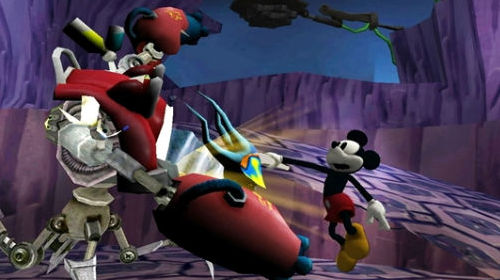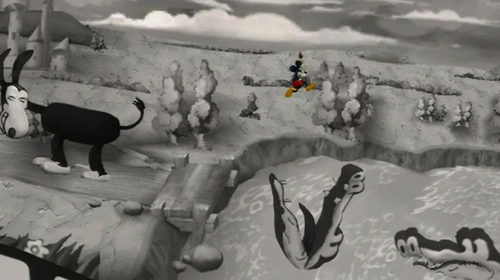Mickey Mouse has become a mascot, so much so that many young people have no real idea that he was once a pretty great cartoon character. Enter Warren Spector and Epic Mickey, a Wii-exclusive designed to relaunch the lovable mouse, while also introducing the world to Oswald the Lucky Rabbit, Walt Disney’s prior creation that he lost the rights to oh so many years ago. Sadly, Mickey and Oswald both deserve better than this.
Epic Mickey starts out as Mickey is pulled into the Wasteland through a series of events brought about by pure mischief. See, in the olden days before Donald Duck, Mickey was the one who was always getting into trouble and it appears that Disney is looking to bring that aspect of his personality back to the forefront. Messing about with Yen Sid’s magic paintbrush leads the Mouse on a great adventure, trying to undo the damage done by the Shadow Blot, which Mickey inadvertently created.
Upon entering the Wasteland, Mickey meets Oswald, the Lucky Rabbit, who is frankly, pretty adorable as designed in the game. Oswald is the ruler of Wasteland and he is none too fond of Mickey after being discarded by Walt and watching Mickey rise to great heights of popularity. The fact that Mickey also caused the Shadow Blot to wreck Oswald’s world only adds to the resentment. The story actually has a decent premise, although you can imagine where it leads.
The world of Epic Mickey is visually interesting, being a mix of distorted locations from Disney theme parks, such as Mean Street instead of Main Street and some steampunk aesthetics, but the general feel of Wasteland is kind of blah. By that I mean it just feels dull and without color, which makes perfect sense in relation to the story, but it doesn’t exactly pop off the screen. It’s akin to the problems that Fallout 3 had: it looks good, but doesn’t exactly catch the eye. Anyone walking by while you play is more likely to wonder why you have the contrast set so low on your TV than anything else. There is one standout location, which is basically a junkpile full of Mickey memorabilia. Pretty nifty.
The main gameplay feature of Epic Mickey is the magic paintbrush, which Mickey uses to either dispense paint or thinner, depending on the situation. Paint rebuilds the environment, for instance, repairing a bridge so you can cross it or fixing a ruptured, steam-expelling pipe in order to pass by safely. Thinner, on the other hand, destroys things, effectively erasing them from the world. If something you want is stacked way up high on a couple of boxes, just use thinner to make the boxes disappear and the item come crashing down. Simple and easy.
The problem with this system is that it’s pretty limited, not to mention binary. As you would expect, most of the world is not affected by the paint or thinner, which means you only need it to solve a puzzle. The binary aspect comes in when it is time to choose which to use. The game makes a lot of fuss about using paint to rebuild the world being a better thing to do (i.e. moral choice) while the thinner, while not exactly evil (this is Mickey Mouse we’re talking about) is still good, just kind of selfish and douche-y. I never really felt like the choices I was making in this regard was having all that much of an effect on the world.
The paintbrush is also used to defeat enemies. The thinner will destroy them, while the paint will make them your allies, so they either attack any unfriendly enemies or they just wander around harmlessly. Honestly, there is so little challenge in defeating them it would have almost been better if they had not included any enemies at all. It’s literally no fun at squirting them with paint or thinner, just a mild inconvenience. Boss battles are much the same, with you choosing to use either paint or thinner and targeting different areas depending on your choices, the most memorable of these battling Robo Captain Hook. Yes, you read that right.
The gameplay consists of an overly long tutorial, holding your hand and telling you exactly what to do and exactly where to go. The problem with this is, when it was over, the game’s objectives were completely unclear. When you enter a new area, you have no idea what to do or where to go until you explore around and talk to the right person or muck about until something happens. I know it sounds nit-picky, but surely they could have found a happy medium between hand-holding and obtuse.
The game, sadly, consists of fetch quests and sluggish platforming, all coupled with a camera that is more frustrating than any I have seen since…wait for it…the Nintendo 64 days. The camera follows you around as you move, but never in a way that you want. For example, if you are trying to jump onto a platform, odds are the camera will move in front of you, so you are jumping towards it. As you can imagine, this is not conducive to a safe landing. You can move the camera with the D-Pad (the game uses the Nunchuk/Wii Remote combo), but it is slow and cumbersome. The end result is that you spend much of your time fighting the camera in order to obtain the desired angle, which isn’t all that much.
Not the quests in the game give you a reason to want to keep playing either. Oftentimes, you are simply running from one area to another, collecting some Macguffin for some character or another. Thanks to the dullness of combat, this isn’t exactly thrilling. To make matters worse, any alterations you make to the world with paint or thinner are reset when you exit and return, so be prepared to perform the same humdrum tasks over and over again if you want to make any progress.
There was one thing that I absolutely loved about the game though. The manner in which you travel from world to world is by jumping to a projection screen that is playing a classic Mickey Mouse cartoon, such as Steamboat Willy. The game then becomes a 2D side-scrolling platformer and a great one at that, with beautiful animation and fun jumping puzzles. Honestly, if the whole game were like this, I would have enjoyed it a lot more.
One final thing I want to mention, which isn’t good or bad, but odd: there is no voice acting. Normally, I would never call attention to this, but Mickey Mouse has a voice. It’s a known quantity, so why not use it? My guess is that maybe they didn’t want to have to cast Oswald (if he even ever spoke. I have no idea) or something like that, but it does seem to be a glaring omission.
Despite the overly negative review, Epic Mickey isn’t a terrible game. It’s just an average one. It really feels like something from one or two generations ago. It certainly fails to live up to its name. With the right fixes, they could make a heck of a sequel, but it’s kind of disappointing that this game, like so many, is going to need a sequel to redeem. It would be nice if they had gotten it right the first time, but sadly, they didn’t. There are some people who might really love this game, but I am not one of them.
Has anyone else played this? Anyone disagree with me?
GamerSushi Grade:

How does our grading system work? Check out our grade chart!




It’s a shame this game received such subpar reviews. If anyone ever saw the concept art for this game, it looked like it was shaping up to be a very gritty, even edgy game, what with deformed robotic pink elephants and fucked up animatronic bears. It’s a shame to see such a cool concept fall by the wayside.
Such a disappointment, it had so much potential. I’m glad I don’t have a Wii otherwise I would have considered getting it.